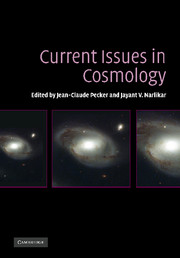Book contents
- Frontmatter
- Contents
- List of contributors
- Preface
- Part I Observational facts relating to discrete sources
- Part II Observational facts relating to background radiation
- Part III Standard cosmology
- Part IV Large-scale structure
- Part V Alternative cosmologies
- Part VI Evidence for anomalous redshifts
- Part VII Panel discussion
- 20 Panel discussion
- 21 General discussion
- 22 Concluding remarks
- Index
21 - General discussion
Published online by Cambridge University Press: 15 December 2009
- Frontmatter
- Contents
- List of contributors
- Preface
- Part I Observational facts relating to discrete sources
- Part II Observational facts relating to background radiation
- Part III Standard cosmology
- Part IV Large-scale structure
- Part V Alternative cosmologies
- Part VI Evidence for anomalous redshifts
- Part VII Panel discussion
- 20 Panel discussion
- 21 General discussion
- 22 Concluding remarks
- Index
Summary
Q : M. MOLES :
There is a theoretical possibility to differentiate between stationary and evolutionary models: To look for cosmic evolution, in particular to verify TCMBR = To(1 + z).
A : G. BURBIDGE :
You are correct, and attempts are being made to verify that TCMBR = To(1 + z).
A : A. BLANCHARD :
Yes, this is a way to test expansion. It has already been attempted and results are consistent with the standard picture. The time dilatation of the apparent duration of SNIa light curves is another interesting test whose results also agree with the standard picture.
Q : M. MOLES :
It has been said that we cannot ask a theory to integrate all the observational facts at once. What we would need, if the aim is to build an alternative cosmology, is a change in perspective.
Both the standard and quasi-static cosmology accept expansion as the primary mechanism to understand the z-phenomenon. Whereas it is perfectly acceptable, it rests on the hypothesis that the general behavior of the space-time is the cause for the observed z-distance relation. A completely different view can be put forward, trying to look for a different explanation for the z-phenomenon. This could then be, in principle, tested at the laboratory level, as stated by Zwicky in 1929. In those views, started by Pecker, Vigier, Molés, and others, the CMBR could be understood as a phenomenon related to the z-phenomenon.
- Type
- Chapter
- Information
- Current Issues in Cosmology , pp. 248 - 260Publisher: Cambridge University PressPrint publication year: 2006



